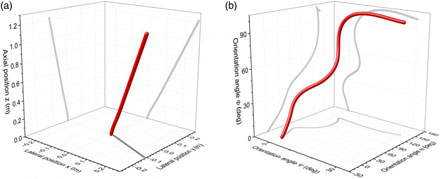
Lasers May Remove Space Debris Using Novel Approach
source:Photonics.com
Time:2016-08-19
Laser ablation can be used to remove interference in satellite communications by pushing pieces of space debris into the Earth’s atmosphere, where the debris is destroyed. A novel approach to laser ablation of space objects focuses on a secondary effect of laser-induced damage, which is not immediately apparent in experiments on Earth but becomes relevant in the weightlessness of space: when laser-induced material ablation occurs, the recoil of the ablation plume yields momentum transfer to the target. Irregularly shaped objects (typical of most space debris) that are randomly oriented in space pose a challenge, in that it is difficult to predict the amount and direction of the laser impulse to impart to the target.
An important piece of information needed for space debris removal is the position of the fragment. Current methods for determining position use reflections caused by the space debris. While radar-based methods use the reflection of the radio waves sent out by the radar stations themselves, optical detection depends on the reflection of sunlight from the debris target in question.
Laser Ablation of Space DebrisResearchers at the German Aerospace Center simulated laser-ablative impulse coupling to space debris targets with the goal of modifying the debris’ orbit and achieving its removal by burn-up in the Earth’s atmosphere. They developed a simulation code, Examination Program for Irregularly Shaped Debris Targets (EXPEDIT), to use in the investigation of the thrust generation through laser ablation with variable parameters.

This figure shows the trajectory of (a) position and (b) orientation of pliers under repetitive laser irradiation without tracking. Grey lines indicate the projections of the trajectory in the respective coordinate planes. Courtesy of Stefan Scharring, Jascha Wilken and Hans-Albert Eckel.
They investigated simple targets and realistic space debris targets with respect to momentum generation. The predictability of the momentum was analyzed in a Monte Carlo study. Results showed that even slight variations of the initial debris position and orientation could lead to significant differences in the trajectories.
The researchers identified targets that were relatively easy to remove by laser ablation, as well as targets that were strongly dependent on orientation. They found that the optimum impulse receiver for laser-induced momentum generation appeared to be a perfectly flat plate oriented perpendicular to the incoming laser beam. By contrast, surface elements whose normals were inclined against the laser beam received a lower laser fluence. Moreover, the corresponding impulse vector contained a lateral component oriented perpendicular to the beam propagation axis.
One way to account for the effects of decreasing fluence and deviating thrust direction, referred to as the area matrix concept, provides for the analytical calculation of laser-induced momentum that is applied to a target exhibiting a simple geometric shape. However, this approach neglects to account for the effects caused by geometrically complex and randomly oriented targets.
“Our work constitutes the transition from laboratory experiments with idealized flat targets and optimum laser alignment towards simulations of the real world scenario with arbitrarily shaped debris and limited laser pointing accuracy,” said the researchers, Stefan Scharring, Jascha Wilken and Hans-Albert Eckel.
Despite limited predictability for the motion of a particular debris object, the researchers found that a laser-based approach appears to be suitable for space debris removal, when using a probabilistic and not a deterministic treatment of the resulting trajectory modifications.
MOST READ
- RoboSense is to Produce the First Chinese Multi-beam LiDAR
- China is to Accelerate the Development of Laser Hardening Application
- Han’s Laser Buys Canadian Fiber Specialist CorActive
- SPI Lasers continues it expansion in China, appointing a dedicated Sales Director
- Laser Coating Removal Robot for Aircraft
PRODUCTS
 FISBA exhibits Customized Solutions for Minimally Invasive Medical Endoscopic Devices at COMPAMED in
FISBA exhibits Customized Solutions for Minimally Invasive Medical Endoscopic Devices at COMPAMED in New Active Alignment System for the Coupling of Photonic Structures to Fiber Arrays
New Active Alignment System for the Coupling of Photonic Structures to Fiber Arrays A new industrial compression module by Amplitude
A new industrial compression module by Amplitude Menhir Photonics Introduces the MENHIR-1550 The Industry's First Turnkey Femtosecond Laser of
Menhir Photonics Introduces the MENHIR-1550 The Industry's First Turnkey Femtosecond Laser of Shenzhen DNE Laser introduced new generation D-FAST cutting machine (12000 W)
more>>
Shenzhen DNE Laser introduced new generation D-FAST cutting machine (12000 W)
more>>
